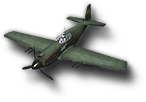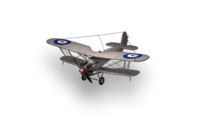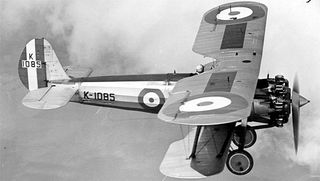Bristol Bulldog
Bulldog
| 2900 價格 |
| 90 生命值 |
| 1686 公斤重量 |
| 35.7 傷害 |
| 838.6 飛行速度 |
| 300 公里/小時海平面上的最高速度 |
| 300 公里/小時最佳高度下的最高速度 |
| 700 公尺理想高度 |
| 470 公里/小時最大俯衝速度 |
| 65.6 公尺/秒爬升率 |
| 70 公里/小時失速速度 |
| 237.5 公里/小時理想飛行速度 |
| 85.4 操控性 |
| 8 秒迴轉 360 度的平均時間 |
| 100 °/秒翻滾率 |
| 1517.7 機動性 |


引擎
| 階級 | 引擎 | 引擎輸出, 匹馬力 / 推力 | 類型 | 重量, 公斤 | 價格, |
|---|---|---|---|---|---|
| I | Jupiter VII | 450 | 空冷式 | 330 | 890 |
| III | Mercury VIS | 605 | 空冷式 | 438 | 4100 |
| III | NAME_MODULE_MERCURY-VIS_SPEC_TOP_BRISTOL-TYPE-105_1 | 605 | 空冷式 | 438 | 4100 |

機體
| 階級 | 機體 | 生命值 | 重量, 公斤 | 價格, |
|---|---|---|---|---|
| I | Bulldog I | 90 | 1296 | 850 |
| II | Bulldog IIa | 100 | 1310 | 1700 |

斷續器上的機槍
| 階級 | 機槍 | 口徑 | 槍口初速, 公尺/秒 | 傷害 | 射擊速率, 發/分鐘 | 重量, 公斤 | 價格, |
|---|---|---|---|---|---|---|---|
| I | .303 Vickers Mk.I (續) | 7.7 | 960 | 17 | 600 | 30 | 0 |
| II | .303 Vickers Mk.II (續) | 7.7 | 960 | 21 | 600 | 30 | 2700 |

Compatible Equipment
Compatible Consumables
Player Opinion
Pros and Cons
Pros:
Good turn rate. Easy to use and can be very versitile. Has the firepower to stay in a fight.
Historical Info
The Type 105 was an unequal span single bay biplane powered by a supercharged Bristol Jupiter VII air-cooled radial engine driving a two-bladed propeller. The structure was all-metal with a fabric covering, using members built up from rolled high-tensile steel strips riveted together. In order to ensure the maximum field of view there was a large semi-circular cutout in the trailing edge of the upper wing and the inboard section of the lower was of reduced chord. Frise ailerons were fitted to the top wing only. It was armed with a pair of 0.303 in (7.7 mm) Vickers machine guns mounted either side of the cockpit.
The prototype Bulldog first flew on 17 May 1927. Initial testing was entirely satisfactory and it was delivered to RAF Martlesham Heath in June. After initial consideration of all the types entered to meet the specification, the Bulldog and the Hawker Hawfinch were selected for more detailed evaluation. While the Bulldog's manoeuvrability and strength were praised by the RAF, it had poor spinning recovery properties. This was solved by fitting an enlarged fin and rudder, but this modification led to difficulties in taxying cross-wind.
Accordingly, a second prototype with a lengthened rear fuselage was ordered for further evaluation in comparison with the Hawfinch. In this form, designated the Type 105A or Bulldog Mk. II was first flown by Cyril Uwins on 21 January 1928 and shortly afterward, delivered to Martlesham Heath. Performance was so close to that of the Hawfinch that a decision was deferred until the aircraft had been evaluated by service pilots; the eventual choice of the Bulldog was made largely because it was easier to maintain. An initial contract for 25 aircraft was placed: Bristol accordingly laid down 26 airframes, the additional example being intended as a company demonstration aircraft. The first of these were delivered on 8 May 1929 and deliveries were complete by 10 October.
Later production aircraft were of a refined version designated the Mk. IIA. This had revised wing spars and a stronger fuselage and was powered by the uprated Jupiter VII F. One production aircraft was modified for use as an advanced trainer: after evaluation by the Central Flying School at Upavon this was ordered by the RAF, the production aircraft differing from the prototype in having slightly swept wings and an enlarged fin to improve spin recovery characteristics.
The Bulldog never saw combat with the RAF, although during the Abyssinia Crisis of 1935–36, Bristol Bulldogs were sent to the Sudan to reinforce Middle East Command. Douglas Bader, better known for his Second World War actions, lost both of his legs when his Bristol Bulldog crashed while he was performing unauthorised Aerobatics at Woodley airfield near Reading.
The Bulldog was withdrawn from RAF Fighter Command in July 1937, being primarily replaced by the Gloster Gauntlet. The Bulldog's RAF career was not over though, for the type continued to serve for a few years with Service Flying Training Schools.
The Bulldog proved to be quite a successful export to foreign air forces, seeing service with Australia, Denmark, Estonia, Finland, Japan, Latvia, Siam and Sweden.
In 1936, Latvia, keen to replace its elderly Bulldogs with more modern aircraft, sold 11 Bulldogs to Basque nationalist forces; becoming part of the Spanish Republican Air Force in the Spanish Civil War, they remained in use until the Battle of Santander. Ten Bulldogs also saw combat as part of the Finnish Air Force during the Winter War against the Soviet Union, which began in 1939. The Bulldogs fought well against their Soviet opponent, gaining six kills by five pilots for the loss of one of their own, the types shot down being two Polikarpov I-16s and four Tupolev SBs, both of which were superior in terms of technology compared to the Bulldog. The first aerial victory of the Finnish Air Force was achieved by a Bulldog piloted by SSgt Toivo Uuttu on 1 December 1939, over an I-16. The Bulldogs were used in advanced training during the subsequent Continuation War against the Soviet Union.
Historical Gallery
Sources and External Links
| Fighters | IIBristol Bulldog • IIIBristol Type 133 • IIIHawker P.V.3 • IIISupermarine Type 224 • IVBristol Type 146 • IVFairey Fantome • IVHawker Hurricane Mk. Ia • VCAC CA-12 Boomerang • VMiles M.20 • VSupermarine Spitfire I • VSupermarine Spitfire Mk Ia • VVickers Venom • VINorth American Mustang Mk.I • VINorth American Mustang IA • VISupermarine Spitfire V • VISupermarine Spitfire Vb IM • VISupermarine Spitfire Vb • VIIGloster Meteor F. I • VIISupermarine Spitfire IX • VIIISupermarine Spitfire XIV • VIIIDe Havilland DH.100 Vampire F.1 • IXSupermarine Attacker • XSupermarine Swift |
| Heavy Fighters | IVBristol Blenheim F • VBristol Beaufighter • VBristol Beaufighter V • VIDe Havilland 98 Mosquito • VIIDe Havilland 103 Hornet • VIIIWestland P.1056 • IXGloster P.228 • XGloster Javelin |
| Attack Aircraft | IIICAC CA-1 Wirraway |

